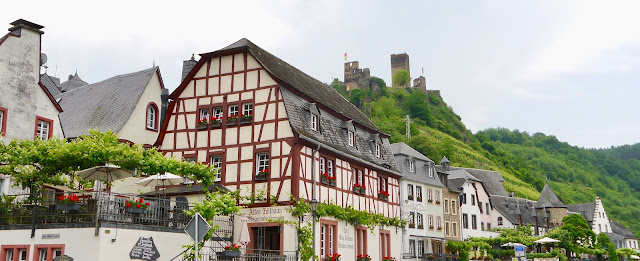Zamek Metternich w Beilstein, malowniczym miasteczku w dolinie Mozeli /Metternich Castle in Beilstein in a picturesque town in the Mosellevalley
..
Kamień jest mokry - deszcz Stone is wet - rain
Kamień rzuca cienie - słońce Stone casts shadows - sun
Kamień nie rzuca cienia - pochmurno Stone casts no shadow - cloudy
Kamień jest biały - śnieg Stone above white - snow
Kamień jest trudny do zobaczenia - mgła Stone is bad to see - fog
Kamien kołysze się - wiatr Stone vibrates - wind
Kamień podskakuje w górę i w dół -
Kamień pod wodą - powódź Stone under water - flood
Kamień zniknął - ukradziony Stone is gone - stolen
Beilstein to małe piękne miasteczko położone wzdłuż spokojnej rzeki Mozeli.
Beilstein nazywane jest "Śpiąca królewną rzeki Mozeli" a to z powodu
jego historycznej niedostępności i pięknej scenerii. Aż
do wczesnych lat XX wieku Beilstein był dostępny tylko przez wodę ...
dziś do miasta porowadzi droga.
Beilstein zachowało swój stary
charakter: można zobaczyć tu wiele domów z muru pruskiego z XVII-XIX wieku, pozostałości kamiennych
fortyfikacji miejskich, dawną kaplicę, dawną
synagogę i cmentarz żydowski, (za zamkiem, na wzgórzu).
Mieszkańcy w liczbie ok.180 prowadzą pensjonaty i restauracje, a wzgórza dokoła miasteczka, tak jak dawniej, pokryte są winoroślą.
Beilstein is a small beautiful town located along the peaceful river Moselle. Beilstein is called the "Sleeping Beauty of the Moselle" because of its historical unavailability and beautiful scenery. Until the early years of the 20th century Beilstein was only accessible by water ... today the road will lead to the town.
Beilstein kept its old character: you can see here many half-timbered houses from the 17th and 19th centuries, the remains of stone city fortifications, the former chapel, the former synagogue and the Jewish cemetery (behind the castle on the hill). Residents in the number of about 180 run guesthouses and restaurants, and the town's hills are covered with vines.
Beilstein kept its old character: you can see here many half-timbered houses from the 17th and 19th centuries, the remains of stone city fortifications, the former chapel, the former synagogue and the Jewish cemetery (behind the castle on the hill). Residents in the number of about 180 run guesthouses and restaurants, and the town's hills are covered with vines.
Zamek Metternich
Zamek pochodzi z XII wieku i został zniszczony przez wojska
francuskie w 1689 roku, gdy był własnością rodziny Metternichów. Po zniszczeniu zamku Beilstein, rodzina Metternich zbudowala później Haus Lipmann w 1714 roku (aktualnie hotel).
Metternich Castle - the castle dates from the 12th century and was destroyed by the French army in 1689, when it was owned by the Metternich family. After the destruction of the Beilstein castle, the Metternich family later built Haus Lipmann in 1714 (currently a hotel).
Kamień pogody - stacja pogody w czasach średniowiecznych.
Na terenie zamku Metternich znalazłam stację pogody, gdzie wskaźnikiem pogody było zachowanie i wygląd kamienia. Tablica powyżej tego kamienia wyjaśniała warunki pogodowe.
Weather stone - weather station in medieval times.
In the castle of
Metternich I found a weather station, where the behavior and appearance of the stone was the indicator of weather. A plaque above this stone explained the weather conditions.
Kamień jest mokry - deszcz Stone is wet - rain
Kamień rzuca cienie - słońce Stone casts shadows - sun
Kamień nie rzuca cienia - pochmurno Stone casts no shadow - cloudy
Kamień jest biały - śnieg Stone above white - snow
Kamień jest trudny do zobaczenia - mgła Stone is bad to see - fog
Kamien kołysze się - wiatr Stone vibrates - wind
Kamień podskakuje w górę i w dół -
trzęsienie ziemi Stone hops up and down - earthquakes
Kamień pod wodą - powódź Stone under water - flood
Kamień zniknął - ukradziony Stone is gone - stolen
Wspaniałe widoki na miasteczko Beilestein i na dolinę rzeki Mozeli
Jednym
z większych budynków w mieście, poza zamkiem, jest dawny klasztor
karmelitów i katolicki kościół parafialny św. Józefa (Pfarrkirche St.
Joseph). Został on zbudowany pod koniec XVII i na początku
XVIII wieku w stylu barokowym. Po sekularyzacji klasztoru karmelitańskiego, kościół konsekrowano pw. Św. Józefa i był to kościół parafialny.
W kościele znajduje się XII-XIII-wieczna rzeźba zwana Czarną Madonnę z Beilstein, i z tego powodu kościół stał się miejscem pielgrzymek.
Rzeźba Czarnej Madonny prawdopodobnie pochodzi z Hiszpanii.
Rzeźba Czarnej Madonny prawdopodobnie pochodzi z Hiszpanii.
One of the
largest buildings in the city, in addition to the castle, is the former
Carmelite monastery and the Catholic parish church of St. Joseph (Pfarrkirche St. Joseph). It was built at the end of the 17th century and at the beginning of the 18th century in the Baroque style. After the secularization of the Carmelite monastery, the church was consecrated St. Joseph and it was a parish church.
In
the church there is a 12th-13th century sculpture called the Black
Madonna of Beilstein and for this reason the church became a place of
pilgrimage. The sculpture of the Black Madonna probably comes from Spain.






























